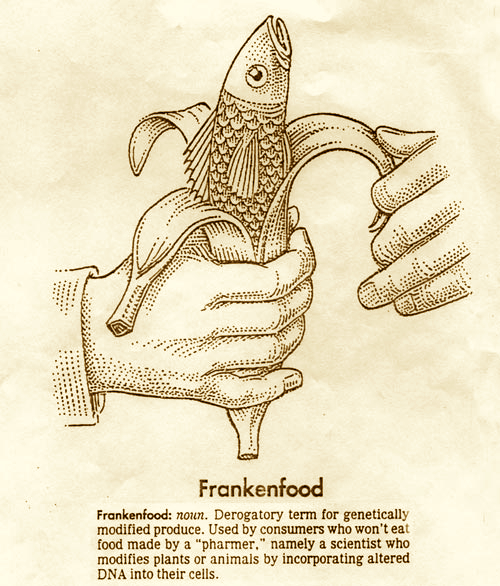
 BY ELIZABETH FIEND LIVING EDITOR Orange juice laced with anchovies, fish genes in ice cream, cheese that kills intestinal parasites, laboratory extracted elements of green tea in your ginger ale, bacteria from yogurt hidden in salsa. Welcome to the supermarket of the 21st century. Not the 21st century to come, I mean today, this is your food store now. Fortified foods aka functional foods are the newest adventure in eating. The fancy name for fortified foods is nutraceuticals. Say that out loud, it’s kind of nauseating. A combo of nutrition and pharmaceutical, this name is trying to convince us that food is medicine. Tropicana now offers an orange juice to stop bone loss and another one to prevent acid reflux. But if you drink OJ for breakfast every day, how do you know how much of the ‘medicine’ you’re getting? And couldn’t this add up to be a pretty caloric way to deliver your dose?
BY ELIZABETH FIEND LIVING EDITOR Orange juice laced with anchovies, fish genes in ice cream, cheese that kills intestinal parasites, laboratory extracted elements of green tea in your ginger ale, bacteria from yogurt hidden in salsa. Welcome to the supermarket of the 21st century. Not the 21st century to come, I mean today, this is your food store now. Fortified foods aka functional foods are the newest adventure in eating. The fancy name for fortified foods is nutraceuticals. Say that out loud, it’s kind of nauseating. A combo of nutrition and pharmaceutical, this name is trying to convince us that food is medicine. Tropicana now offers an orange juice to stop bone loss and another one to prevent acid reflux. But if you drink OJ for breakfast every day, how do you know how much of the ‘medicine’ you’re getting? And couldn’t this add up to be a pretty caloric way to deliver your dose?
During the 90’s nutraceuticals came into prominence. They were originally offered mostly in the form of pills like garlic pills, soy pills or cranberry pills. Food science, a relatively new science, had noted that certain foods seemed to be really good for you. People who consumed these foods had less cancer and heart disease, they didn’t develop diabetes, their bones were strong. So instead of these scientists recommending you eat the healthy and good tasting foods (duh) like tomatoes or blueberries they took a different route. They wanted to know exactly which one, specific micronutrient was responsible for the positive health benefit. So they did a lot of studies and picked one. But time has shown, over and over again, that they can be wrong. That this is not the way nutrients should be delivered into our bodies. That isolating one element away from a whole food doesn’t produce the same positive health benefit as the original food. Maybe that’s because one element isn’t responsible for the positive benefit. Maybe a combination of two different micronutrients is what really works. Or maybe it’s the combination of hundreds of elements in the food. We don’t just know. But apparently, we don’t care either. These failures have not dissuaded the food industry from grasping hold of the concept and producing ever new and startling “foods.” Nestlé, PepsiCo and Dannon are among the many manufacturers who are rolling out new nutraceuticals, aka new food products.
Sure, in the natural state a whole tomato is great for you. Scientists think that maybe the photochemicals lycopene,  lutein and betacarotene are the reason tomatoes are so good for you. But to grow a special variety of tasteless tomatoes in an indoor facility and then extract the lycopene in a lab and microencapsulate it into beadlets so small your tongue can’t feel it? Or even worse, produce synthetic lycopene and insert it into a totally different food and then say that this is a good thing.
lutein and betacarotene are the reason tomatoes are so good for you. But to grow a special variety of tasteless tomatoes in an indoor facility and then extract the lycopene in a lab and microencapsulate it into beadlets so small your tongue can’t feel it? Or even worse, produce synthetic lycopene and insert it into a totally different food and then say that this is a good thing.
Will this new product deliver the same nutrition that the original tomato did? The answer: We don’t know, there is no proof, eat a real tomato. The Food and Drug Administration has no rules and few regulations for both the labeling and manufacturing of fortified foods. There is no good science behind these new products, and there doesn’t need to be. Yet, there they are on your store shelf. Maybe even already in your fridge.
Of course, I think they’re stupid. Maybe even dangerous. Eat REAL foods. Eat WHOLE foods. Eat fruit and vegetables and whole grains. You’ll be fine. Actually better than fine. You want omega 3 fatty acids? Eat omega 3 fatty acids in a natural state. Want the benefits from a tomato? Eat one for crying out loud. Don’t eat some chemical abstraction of these healthy foods. Eat the real thing. It’s scrumptious and good for you. The key to good nutrition: hedge your bets eat a wide range of natural foods. You’re guaranteed to be covered nutritionally and you’ll be so healthy you won’t need pharmaceuticals and definitely not need nutraceuticals. MORE
EDITOR’S NOTE: Miss Fiend has asked that we clarify the difference between ‘frankenfoods’ and ‘nutraceuticals.’ So-called ‘frankenfoods’ have been genetically modified, wherein genes from different species are combined and grown in the laboratory, while ‘nutraceuticals’ result from mixing ingredients, presumably for their health-promoting properties, after the fact. Sorry for the confusion. Please carry on.
ABOUT THIS COLUMN: At no time in recorded history have we possessed so much knowledge about health and nutrition, or had such vast and effective means for disseminating that knowledge. Yet for all that, we essentially live in a high-tech Dark Age, with most of the global population ignorant or confused about the basic facts of their own biology. How did this happen? Well, that alone is a whole six-part miniseries, and this ain’t the Discovery Channel. Suffice to say that the bottom line of many a multi-national corporation depends on that ignorance, and vast sums of money are expended to keep us fat, dumb and happy. But mostly fat. There was a time when newspapers saw it as their duty to truth squad the debates over health, science and the environment, but that’s a luxury most papers can no longer afford — not when there are gossip columnists to be hired! To help remedy this violation of the public’s right to know, Phawker publishes the JUNK SCIENCE column by Elizabeth Fiend, beloved host of the BiG TeA PaRtY. Every week, Miss Fiend connects the dots to reveal a constellation of scientific facts that have been hiding in plain sight, scattered across the cold, vast reaches of the Internet. With a background in punk rock and underground comics, and a long career as a library researcher, Miss Fiend knows how scientific facts become diluted by corporate-sponsored non-facts. Every week she separates the smoke from the mirrors. Why? Because she loves you, ya big dummy.
